The test is your BFF
Why you don’t analyze JLPT?
When it comes to the text, Japanese people including me think about how to pass it in an efficient way and start “テスト対策=Analysis of test”.
Keep in mind these steps;
1) Step 1: Visualize the complete picture of JLPT
2) Step 2: Try the past / mock JLPT
3) Step 3: Analyze JLPT
BFF means “Best Friend Forever”.
What I want to say with this phrase is that you can use the test to your advantage.
If you analyze well the JLPT, you can learn the most efficient way to study for JLPT.
The test is always made by someone and with a specific intention, so it is very important to ANALYZE it!
Please trust me and read this all the way through to find out how to analyze it!!!🤲
【Step 1】Visualize the complete picture of JLPT
What is the purpose of JLPT?
I suggest strongly that you save time and money to pass JLPT and that you learn a lot of useful Japanese knowledge after entering a Japanese university or joining a company. If you analyze the JLPT, it is possible!
JLPT is used to measure your Japanese level especially when you want to find a job in Japan. However, what happens after entering the Japanese company is that you will probably realize the Japanese knowledge you gained through the JLPT journey isn’t very useful…
Wouldn’t it be more ideal to pass the JLPT efficiently and start to learn practical Japanese at work or university?
So, let’s start with Vocabulary.
Vocabulary
Here, you have to gain as much vocabulary as possible because you won’t be able to guess the answer without knowing them. In the case of “Vocabulary”, you have to learn patiently every day.
The objective of this area is to test how quickly you can get the word information out of the drawer in your head. Do you know how quickly??
Please see the part “See if your time allocation was ideal” below.
| Type of test items | N1 | N2 | N3 | N4 | N5 |
| Kanji reading | ○ | ○ | ○ | ○ | ○ |
| Orthography | ― | ○ | ○ | ○ | ○ |
| Word formation | ― | ○ | ― | ― | ― |
| Contextually-defined expressions | ○ | ○ | ○ | ○ | ○ |
| Paraphrases | ○ | ○ | ○ | ○ | ○ |
| Usage | ○ | ○ | ○ | ○ | ― |
But, don’t be disappointed! Even though it requires you to study every day, there is a tip to save time. I wrote about this tip in the article for JLPT N3, so please also check it!
Grammar
What is important in the Grammar section? Either Sentential grammar or Text grammar requires your knowledge of how the expression is used in the text or that of the collocation.
| Type of test items | N1 | N2 | N3 | N4 | N5 |
| Sentential grammar 1 | ○ | ○ | ○ | ○ | ○ |
| Sentential grammar 2 | ○ | ○ | ○ | ○ | ○ |
| Text grammar | ○ | ○ | ○ | ○ | ○ |
For instance, please see the example below.
The correct answer is “1.あるいは”. How did you try to find out the answer?
In many cases, if you look at the before and after the ( ), you can guess the answer.
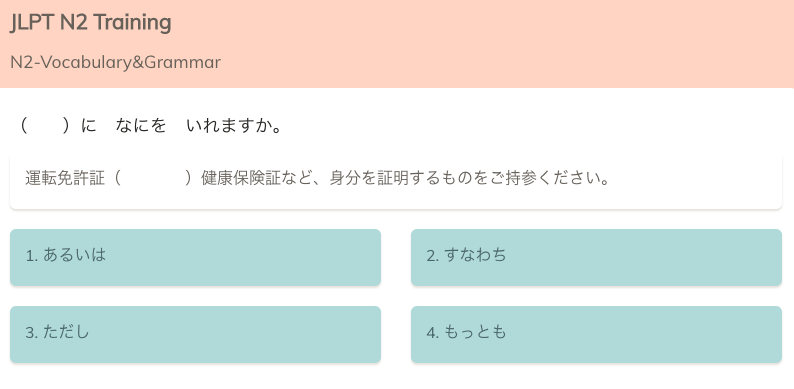
Let’s examine the options one by one.
- あるいは: or
→「運転免許証( or )健康保険証など、」 - すなわち:in other words
→「運転免許証( in ohter words )健康保険証など、」 - ただし :however if
→「運転免許証( however, if )健康保険証など、」 - もっとも:only in certain condition
→「運転免許証( only in certain condition )健康保険証など、」
Which option do you think makes more sense?
運転免許証(driver licence) isn’t the same as 健康保険証(Insurance card), that is why the number 2.すなわち isn’t the correct answer.
The number 3.ただし is used to mean condition, so it isn’t appropriate for this situation.
The number 4.もっとも is also used to state a reason, fact, condition, exception or limitation that is missing from the previous statement and that you want the other person to know about.
Did you realize that, without looking at the second half, I could find out the right answer? To save time in the exam, you definitely know these mini tips!
Reading
There are various types of comprehension as you can see, but the important tip to get a high score with less time is the same as I mentioned in these articles (JLPT N3 and JLPT N2).
| Type of test items | N1 | N2 | N3 | N4 | N5 |
| Comprehension | ○ | ○ | ○ | ○ | ○ |
| Comprehension | ○ | ○ | ○ | ○ | ○ |
| Comprehension | ○ | ― | ○ | ― | ― |
| Integrated comprehension | ○ | ○ | ― | ― | ― |
| Thematic comprehension | ○ | ○ | ― | ― | ― |
| Information retrieval | ○ | ○ | ○ | ○ | ○ |
Take a look at the questions before starting to read the text!
If you don’t do that, you should probably waste a lot of time. The questions are indicators that tell you where you have to focus.
See the example below. What the author asks you is “どうして(why)“, so what you must do is try to find words that indicate the reason. In this case, “ので(because)” can be found in the 3rd paragraph and you can guess the highlighted part in orange may indicate the answer.
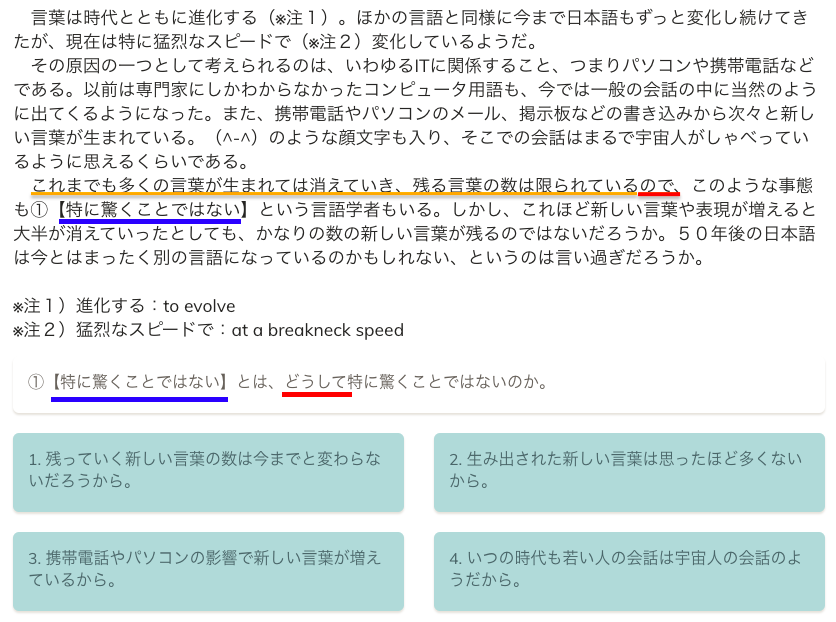
Well, the correct answer is “1”. As I explained above, the highlighted part in orange is directly related to the answer.
<Recommendation>
- Have a look at the question first
- Check a word that can be a indicator
- When reading, mark it with pencil
- Read carefully near the indicator
Listening
Listening is also the difficult part to analyze, but it isn’t impossible to be prepared. So how can you be prepared for the listening of JLPT?
Here are the tips!
As you can see also at the JLPT official site (Links to purposes of test item types for each level), the main purpose of listening is to capture the flow of the conversation.
| Type of test items | N1 | N2 | N3 | N4 | N5 |
| Task-based comprehension | ○ | ○ | ○ | ○ | ○ |
| Comprehension of key points | ○ | ○ | ○ | ○ | ○ |
| Comprehension of general outline | ○ | ○ | ○ | ― | ― |
| Verbal expressions | ― | ― | ○ | ○ | ○ |
| Quick response | ○ | ○ | ○ | ○ | ○ |
| Integrated comprehension | ○ | ○ | ― | ― | ― |
Then, where do you have to focus on when listening to the conversation in the JLPT?
In some parts, the questions are printed on paper, but in other parts, they are not. However, what you have to do is the same, that is, take a note on the paper focusing on these words.
- 5W1H (What, Who, Where, When, Which, How)
- Paradoxical conjunctions
but 、 however (しかし)
although 、 though (~であるとはいえ)
in spite of 、 despite (~にもかかわらず)
even (~でさえも)
in contrast (これに対し)
on the other hand (一方で)
on the contrary (それどころか)
nevertheless 、 nonetheless(にもかかわらず)
regardless of(~を問わず)
yet 、 still (でも) - Expressions that indicate reason (because, since, etc…)
I’m sure it’s the same for you, but the most important thing you want to say comes always after these words mentioned above, right?
So I highly recommend you focus on them in the listening test.
Of course, you need to know all of the words and expressions to understand what they mean, so you need to study every day.
→【IPPO】offers FREE training in Vocabulary, Grammar, Reading, Listening.
【Step 2】Try the past / mock JLPT
Don’t try just to solve questions, but please focus on the structure of the test.
When you have finished solving the questions, pay attention to the factors mentioned in【Step 3】.
The following factors are very important when analyzing the JLPT.
We all want to know how we can solve the questions more efficiently and save time when taking the test, don’t we?
Now let’s look at the most important point!
【Step 3】⭐️Analyze JLPT⭐️
Analyze each section
First, look at the diagram below.
Divide into sections and see where you have difficulty.
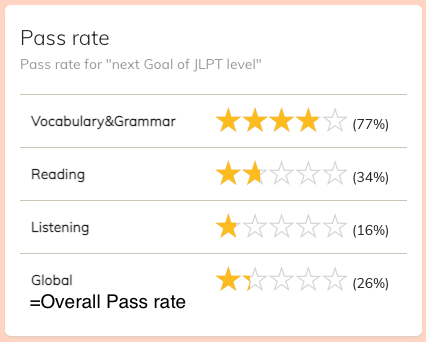
【Vocabulary&Grammar】
It is the areas you are good at that you should first analyze thoroughly.
First, check the questions you got wrong and see if there are areas you are weak in.
See this diagram and mark your weak point.
There are a number of themes within the grammar section alone.
Find out which of these areas you are weak in and make sure you are aware of them.
If you are aware of your weaknesses when you study, you will naturally be able to concentrate better when studying.
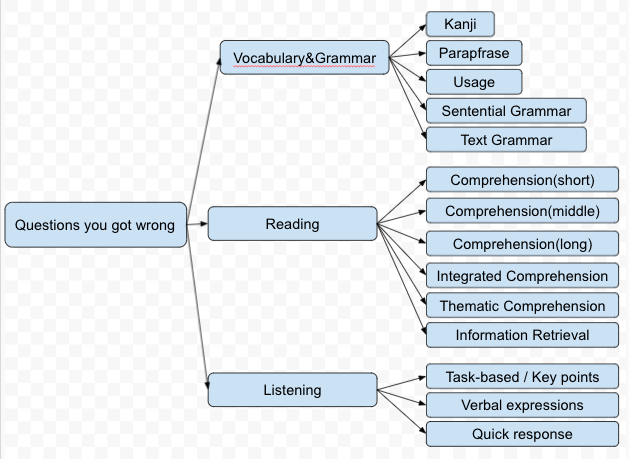
【Reading】
As mentioned in 【Step 1】, there are tips to keep in mind for each section.
By identifying your weaknesses, you can use these tips to help you study more effectively for the test.
For example, let’s say you are not good at Comprehension (long) in Reading. In the JLPT, there are typically three questions per sentence, and you need to be able to find the answer in the whole sentence.
Therefore, you should follow the flow like (1) check the question, (2) check the keyword, (3) check the keyword and indicator in the document, (4) ask the question.
Establishing a method of reading the sentence before taking JLPT is important because you can answer the questions without being nervous in the test.
In addition, do not solve problems based on your own subjectivity.
Even if you think it isn’t normal, the author probably doesn’t think so.
Please choose your answers based on the expressions in the text!
You will need to solve the questions many times to acquire skills, so please using the tips mentioned above, try as many times as possible the past / mock JLPT!
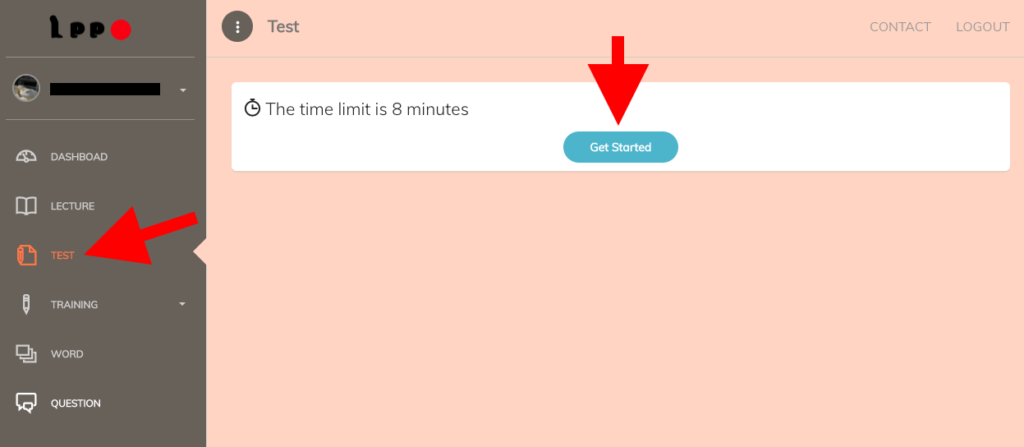
Analyze time allocation
In these two articles (N3 and N2), I already explained the ideal time allocation, so please take a look!
If you want to know the time allocation for N5, N4, and N1, please send a DM on Facebook!
Analyze timing to mark the sheet
Timing to mark the sheet isn’t considered an important factor, but it is!
For instance, in the Grammar section, you will be required to answer all questions within 30 minutes including the time to mark the sheet.
<N3 (Letters & Vocabulary)>
I think there are two patterns to mark the sheet.
ーーーーーーーーーーーーーーーーーーーーーーーーーーーーーーーー
1) Solve all questions first → Mark the sheet
👉42 seconds x 35 questions = 25 minutes
👉Mark the sheet = 5 minutes
ーーーーーーーーーーーーーーーーーーーーーーーーーーーーーーーー
2) Mark the sheet immediately after solving a question
👉50 seconds x 35 questions = 29 minutes
ーーーーーーーーーーーーーーーーーーーーーーーーーーーーーーーー
We don’t want to tell you what to do, because every individual has a different way of solving questions.
However, by deciding when to mark from the start of your study, don’t you think you will be able to solve the questions in the time allotted to you?
If you mark after you have solved the first problem, you decide how much time you have to solve the problem. This means that while you are studying, you can decide “I will solve this number of problems in this amount of time!
【Conclusion】The most important is to pass JLPT!
Let’s make the test be your BBF!
Did you understand why analyzing the test is important and what means the test is your BBF?
I hope you read this article before the JLPT so that you can pass the JLPT!
FREE Training for JLPT
If you want to pass JLPT, we are always with you. Our Japanese learning platform offers you various learning FREE materials (N5〜N1), such as Dashboard to manage your study time, Flashcard for Word, Mini test, Lecture, and Training of Vocabulary&Grammar, Reading and Listening.
© since 2021 GLOBAL ASTRA Inc. All Rights Reserved.

We offer the Best Online Japanese Learning (All Free), and our goal is to facilitate the adoption into life in Japan. Our service “IPPO” is made by native Japanese teachers and professionals. The tips we share with you can help you to learn Japanese efficiently and pass JLPT (Japanese Language Proficiency Test).




